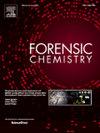致幻蘑菇的DART-HRMS筛选方法
IF 2.6
3区 医学
Q2 CHEMISTRY, ANALYTICAL
引用次数: 0
摘要
全球滥用药物的情况是动态的。新型冠状病毒肺炎疫情后,含裸孢素蘑菇(PCM)再次出现在国际舞台上。为了识别非法药物,必须采用多种分析方法,包括分类(如比色试验)和确认试验(如气相色谱-质谱法)。此外,在许多情况下,只有在分诊方法中给出阳性结果的样本才会被带到确认的样本中。然而,比色法在分析复杂的异常样品(如PCM)时存在一些缺点,可能产生假阴性结果。本研究评估了环境电离技术实时高分辨率质谱直接分析(DART-HRMS)作为鉴别PCM检获样品的分诊方法的可行性。采用1个裸盖菇素标准品、食用菌和5个查获的PCM样品建立了裸盖菇素分析所需的DART-HRMS仪器装置。将开发的DART-HRMS方法与推荐用于PCM筛选分析的分诊方法(Erlich试验)进行比较。而对裸草素溶液的分析在DART网格下施加300 V,载气在150°C,对固体样品的分析施加300 V和375°C。所有查获的PCM样品Erlich’s检测均为阴性,而DART-HRMS检测均为psilocin阳性。根据HRMS数据的质量,有可能确认Erlich的检测结果对扣押的样品是假阴性的。DART-HRMS是一种快速、可靠、值得信赖的鉴别方法,可用于刑事调查的生致幻蘑菇的定性鉴定。本文章由计算机程序翻译,如有差异,请以英文原文为准。

DART-HRMS analysis as a screening method for hallucinogenic mushrooms
The global drug abuse scene is dynamic. After COVID-19 psilocin-containing mushrooms (PCM) reemerged in the international scenario. To identify illicit drugs, multiple analytical methods must be employed including triage (e.g. colorimetric test) and confirmatory tests (e.g. GC–MS). In addition, in many cases, only samples that give positive results in the triage method are taken to the confirmatory ones. However, colorimetric methods have several drawbacks in the analysis of complex unusual samples, such as the PCM, which can produce false-negative results. This study evaluated the feasibility of the ambient ionization technique direct analysis in real time – high-resolution mass spectrometry (DART-HRMS) as a triage method for the identification of PCM seized samples. A psilocin standard, edible mushrooms, and 5 seized PCM samples were used to establish the DART-HRMS instrumental setup required for psilocin analysis. The developed DART-HRMS method was compared to the triage method recommended for PCM screening analysis (Erlich’s test). While the analysis of psilocin solutions applied 300 V at the DART grid and carrier gas at 150 °C, the analysis of solid samples applied 300 V and 375 °C. All seized PCM samples presented negative results in Erlich’s test, while all of them were positive for psilocin by DART-HRMS. Based on the quality of the HRMS data it was possible to confirm that Erlich’s test results were false-negative for the seized samples. DART-HRMS presents itself as a fast, reliable, and trustworthy triage method for the qualitative identification of raw hallucinogenic mushrooms for criminal investigation.
求助全文
通过发布文献求助,成功后即可免费获取论文全文。
去求助
来源期刊

Forensic Chemistry
CHEMISTRY, ANALYTICAL-
CiteScore
5.70
自引率
14.80%
发文量
65
审稿时长
46 days
期刊介绍:
Forensic Chemistry publishes high quality manuscripts focusing on the theory, research and application of any chemical science to forensic analysis. The scope of the journal includes fundamental advancements that result in a better understanding of the evidentiary significance derived from the physical and chemical analysis of materials. The scope of Forensic Chemistry will also include the application and or development of any molecular and atomic spectrochemical technique, electrochemical techniques, sensors, surface characterization techniques, mass spectrometry, nuclear magnetic resonance, chemometrics and statistics, and separation sciences (e.g. chromatography) that provide insight into the forensic analysis of materials. Evidential topics of interest to the journal include, but are not limited to, fingerprint analysis, drug analysis, ignitable liquid residue analysis, explosives detection and analysis, the characterization and comparison of trace evidence (glass, fibers, paints and polymers, tapes, soils and other materials), ink and paper analysis, gunshot residue analysis, synthetic pathways for drugs, toxicology and the analysis and chemistry associated with the components of fingermarks. The journal is particularly interested in receiving manuscripts that report advances in the forensic interpretation of chemical evidence. Technology Readiness Level: When submitting an article to Forensic Chemistry, all authors will be asked to self-assign a Technology Readiness Level (TRL) to their article. The purpose of the TRL system is to help readers understand the level of maturity of an idea or method, to help track the evolution of readiness of a given technique or method, and to help filter published articles by the expected ease of implementation in an operation setting within a crime lab.
 求助内容:
求助内容: 应助结果提醒方式:
应助结果提醒方式:


